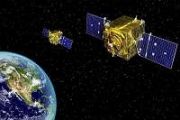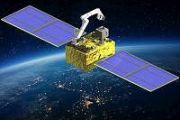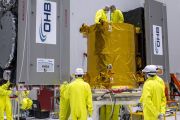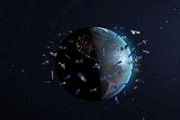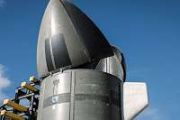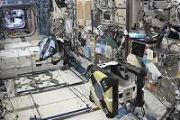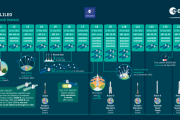
Copernical Team
Branson mum on when he'll launch to space on Virgin Galactic

CubeSat named for pioneer of European planetary defence

As ESA’s Hera mission reaches the Didymos double asteroid system, it will not be there alone: it will also serve as mothership for Europe’s first two ‘CubeSats’ into deep space. Juventas, performing subsurface radar sounding, is called after the daughter of Hera. The other, spectral surveyor Milani, takes the name of the researcher who began Europe’s asteroid risk monitoring system and came up with the original concept inspiring Hera and NASA’s DART – a double spacecraft mission for planetary defence.
Iran says UAV can travel 7,000 km; Drones hit near Iraq's Arbil
 Iran has drones capable of flying 7,000 kilometres (more than 4,000 miles), the commander of its Revolutionary Guard force said Sunday.
"We have drones which can fly 7,000 kilometres, without a pilot, and land back at the same spot or anywhere else," General Hossein Salami said in a speech broadcast by state television.
He gave no other details but the new drone would give it a range of
Iran has drones capable of flying 7,000 kilometres (more than 4,000 miles), the commander of its Revolutionary Guard force said Sunday.
"We have drones which can fly 7,000 kilometres, without a pilot, and land back at the same spot or anywhere else," General Hossein Salami said in a speech broadcast by state television.
He gave no other details but the new drone would give it a range of Weapons System installation begins at Aegis Ashore Poland
 Installation of the Aegis Ashore Poland's Aegis Weapon System has begun. The Missile Defense Agency (MDA) recently achieved critical installation milestones of the Aegis Weapon System at its Redzikowo, Poland, facility whose design and construction efforts are being accomplished in close partnership with the U.S. Army Corps of Engineers (USACE).
In March, the Aegis Weapon System completed
Installation of the Aegis Ashore Poland's Aegis Weapon System has begun. The Missile Defense Agency (MDA) recently achieved critical installation milestones of the Aegis Weapon System at its Redzikowo, Poland, facility whose design and construction efforts are being accomplished in close partnership with the U.S. Army Corps of Engineers (USACE).
In March, the Aegis Weapon System completed Airbus to provide satellite-based maritime surveillance services for the UK Royal Navy
 The UK Royal Navy has awarded a 12 month contract extension to Airbus covering the continued provision of satellite-based maritime surveillance services for the Joint Maritime Security Centre (JMSC).
The contract follows the successful completion of a proof of concept phase, and will ensure the continued monitoring of areas of interest in UK waters and ultimately protect UK sovereign borde
The UK Royal Navy has awarded a 12 month contract extension to Airbus covering the continued provision of satellite-based maritime surveillance services for the Joint Maritime Security Centre (JMSC).
The contract follows the successful completion of a proof of concept phase, and will ensure the continued monitoring of areas of interest in UK waters and ultimately protect UK sovereign borde SpaceX postpones launch of 88 satellites in rideshare mission to Wednesday
 SpaceX postponed a launch Tuesday to send 88 small satellites into orbit from Florida in what is known as a rideshare launch due to interference from a possible plane in the region, a SpaceX announcer said.
"It looks like the [launch] range was a no go. There might have been an airplane in the area. We do have a backup opportunity tomorrow, but for today, that's going to do it for us,"
SpaceX postponed a launch Tuesday to send 88 small satellites into orbit from Florida in what is known as a rideshare launch due to interference from a possible plane in the region, a SpaceX announcer said.
"It looks like the [launch] range was a no go. There might have been an airplane in the area. We do have a backup opportunity tomorrow, but for today, that's going to do it for us," Northrop Grumman building 'Justified Confidence' for Integrated Artificial Intelligence Systems
 "Justified confidence" in artificial intelligence is more than just new buzzwords. It's about developing AI systems that are robust, reliable and accountable, and ensuring these attributes can be verified and validated.
The National Security Commission on Artificial Intelligence's (NSCAI) Final Report highlights emerging consensus on the principles for using AI ethically and responsibly fo
"Justified confidence" in artificial intelligence is more than just new buzzwords. It's about developing AI systems that are robust, reliable and accountable, and ensuring these attributes can be verified and validated.
The National Security Commission on Artificial Intelligence's (NSCAI) Final Report highlights emerging consensus on the principles for using AI ethically and responsibly fo Evidence on UFOs 'largely inconclusive': US intelligence report
 A highly awaited US intelligence report on dozens of mysterious unidentified flying object sightings said most could not be explained, but did not rule out that some could be alien spacecraft.
The unclassified report said researchers could explain only one of 144 UFO sightings by US government personnel and sources between 2004 and 2021, sightings that often were made during military trainin
A highly awaited US intelligence report on dozens of mysterious unidentified flying object sightings said most could not be explained, but did not rule out that some could be alien spacecraft.
The unclassified report said researchers could explain only one of 144 UFO sightings by US government personnel and sources between 2004 and 2021, sightings that often were made during military trainin Gilmour Space rockets ahead with new funding round
 Australia's leading launch services company, Gilmour Space Technologies, has secured $61 million (approximately $47 million USD) from global investors in what is the largest private equity investment raised by a space company in Australia.
The Series C round, which includes US-based Fine Structure Ventures, Australian venture capital firms Blackbird and Main Sequence, and Australian supera
Australia's leading launch services company, Gilmour Space Technologies, has secured $61 million (approximately $47 million USD) from global investors in what is the largest private equity investment raised by a space company in Australia.
The Series C round, which includes US-based Fine Structure Ventures, Australian venture capital firms Blackbird and Main Sequence, and Australian supera Power on: new solar arrays installed over three spacewalks

ESA astronaut Thomas Pesquet and NASA astronaut Shane Kimbrough performed three spacewalks in the span of 10 days to install two new solar arrays that will generate more electricity on the International Space Station.







